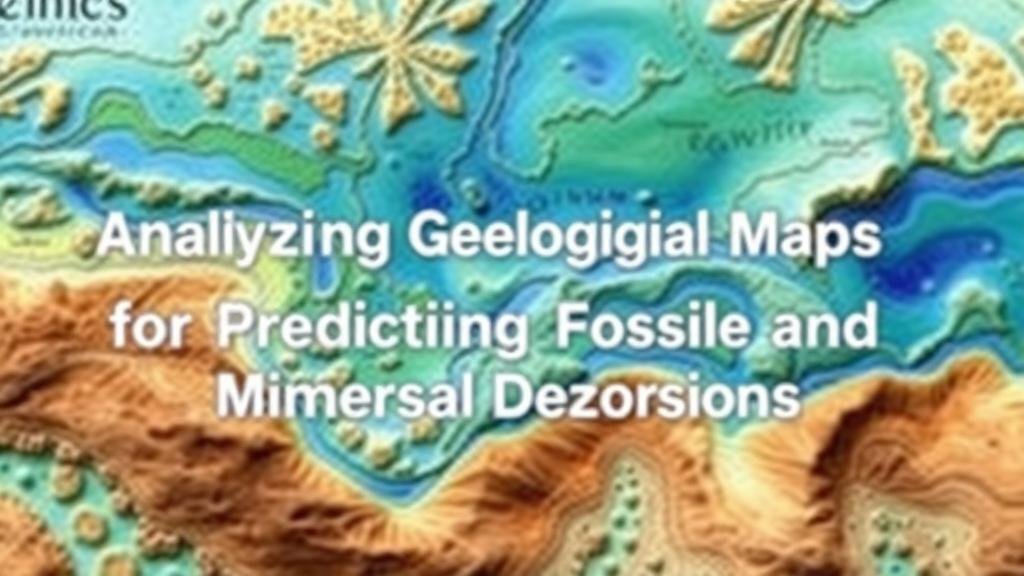Analyzing Geological Maps for Predicting Fossil and Mineral Deposits
Analyzing Geological Maps for Predicting Fossil and Mineral Deposits
The study of geological maps is a vital aspect of both academic research and practical applications in fields such as paleontology and mineral exploration. Geological maps serve as synthesized representations of geological features across a given area, delineating different rock types, structures, and the geological history of a region. This article delves into the methodologies and analytical techniques used in interpreting geological maps to make predictions regarding fossil and mineral deposits.
The Importance of Geological Maps
Geological maps are essential tools in the field of Earth sciences. allow researchers and exploration geologists to visualize subsurface materials and understand the spatial distribution of resources. These maps typically include data related to:
- Rock units and their distribution
- Geological structures such as faults and folds
- Age relationships between different rock formations
For example, in the Canadian Shield, geological maps reveal ancient Precambrian rock formations. The detailed mapping of these regions has led to significant discoveries of mineral deposits such as nickel and copper. According to Natural Resources Canada, the region produced over 1.6 million tonnes of nickel from 2019 to 2021.
Methods for Analyzing Geological Maps
Analyzing geological maps involves several methodologies, including stratigraphy, structural geology, and paleoecology. Each of these disciplines provides insight into the predictive capabilities of geological mapping concerning fossil and mineral deposits.
Stratigraphic Analysis
Stratigraphy involves studying the layering of rocks, which can indicate the environmental conditions under which they were formed. For example, regions with well-preserved sedimentary layers may suggest favorable conditions for fossil preservation. In the Hell Creek Formation of Montana, detailed stratigraphic analysis has correlated sandstone layers with the fossil remains of dinosaurs, providing clues about the ancient ecosystem.
Structural Geology
Understanding the structural makeup of an area, including faults and folds, is crucial for predicting mineral deposits. Structural traps, for example, can form accumulations of oil and gas. A case study in the Gulf of Mexico highlights how analyzing geological maps that illustrate salt dome structures led to significant hydrocarbon discoveries. U.S. Energy Information Administration reported that the Gulf of Mexico produced 1.9 million barrels of oil per day in 2021, largely due to insights derived from geological mapping.
Paleoecological Context
Paleoecology relies on interpreting geological maps to reconstruct ancient environments, which can be valuable for locating fossil deposits. For example, the famous La Brea Tar Pits in Los Angeles provide insights into Pleistocene megafauna through careful geological mapping of the asphalt layers. This paleontological site has yielded thousands of fossil specimens, contributing to our understanding of prehistoric ecosystems.
Technological Advancements in Geological Mapping
With technological advancements, the process of analyzing geological maps has become increasingly sophisticated. Geographic Information Systems (GIS) and remote sensing have revolutionized the capacity to analyze geospatial data. For example, satellite imagery allows geologists to identify surface features that are indicative of subsurface resources, such as mineral veins and fossiliferous sediments.
Case Study: GIS in Mineral Exploration
A study conducted by the United States Geological Survey in the Nevada region employed GIS to assess mineral potentials. By overlaying geological maps with geochemical data, researchers successfully identified areas with high prospects for gold deposits. The result was a significant increase in exploration activities in these targeted areas, illustrating how GIS can enhance geologic predictive capabilities.
Challenges and Limitations
While geological maps are invaluable, there are inherent challenges and limitations. One major concern is the quality and resolution of the data used in mapping. In regions where data is sparse or of poor quality, predictions regarding fossil and mineral deposits may lead to errors. Also, geological mapping often requires a significant investment of time and resources, and smaller organizations may lack access to advanced analytical tools.
Conclusion
To wrap up, the analysis of geological maps serves as a foundational tool for predicting fossil and mineral deposits. Through established methods of stratigraphy, structural geology, and paleoecology, as well as the integration of modern technological advancements like GIS, researchers can enhance their understanding of Earths geological history and resource distribution.
Future research in this field should focus on improving data quality and developing cost-effective mapping technologies to enable wider accessibility. By harnessing the potential of geological maps, the scientific community can significantly contribute to resource management and conservation efforts.
Actionable Takeaways
- Use geological maps to assess resource potential in specific regions.
- Incorporate advanced technologies like GIS in geological mapping efforts.
- Engage with interdisciplinary teams to enhance analytical capabilities and address limitations in data.



